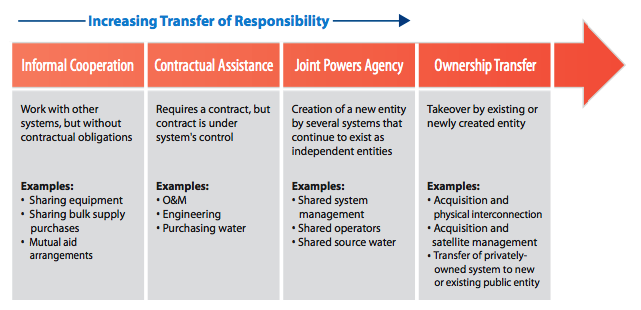
Drinking water and wastewater systems may be able to reduce costs by partnering with other systems. These partnerships can range from informal agreements to the transfer of ownership and creation of a new utility. This post examines a range of partnership options and strategies to reduce costs for common drinking water and wastewater system supplies. Although membership and formality may vary between these types of partnerships, each relies on economies of scale to keep costs low by purchasing supplies in bulk.
Informal Cooperation Arrangements
Some water systems cooperate informally by forming councils or consortiums to negotiate contracts together and purchase in bulk. These informal cooperation arrangements arise from water utilities working directly with each other. While these cooperatives must be allowed through state statute, they remain self-regulated. Two examples are the Northeast/Merrimack Valley Consortium of Water and Wastewater Facilities in Massachusetts and the Southern Maine Regional Water Council.
Northeast/Merrimack Valley Consortium is a group of water and wastewater systems representing 35 towns in the northeast and central Massachusetts and southern New Hampshire. Each year, one system serves as host utility for the Consortium, one system serves as the “buying agent,” and two other systems provide support. Those support systems will become the buying agents over the next two years. The host and the agent work together to draft a bid package that includes the chemical and laboratory supplies needed, quantity of supplies, and delivery specifications submitted by the community systems. After an agreement is awarded to a vendor by the Consortium, each water or wastewater system is responsible for entering into its own individual purchasing contract with that vendor. The member systems are restricted from pursuing vendors independent of the Consortium. Membership in the Northeast/Merrimack Valley Consortium requires that the applicant be a water or wastewater utility in the specified area of Massachusetts or New Hampshire, receive approval to join from a majority of the other members, attend two mandatory meetings each year, and pay a fee of $100 to cover the bidding, procurement, and administration of the Consortium. Northeast/Merrimack Valley Consortium has repeatedly outperformed the Massachusetts State Bid price for water and wastewater chemicals [1].
Southern Maine Regional Water Council is a voluntary organization of seven water districts in the service area extending from Portland south to the New Hampshire border. The primary purposes of the Southern Maine Regional Water Council are collaboration, cost savings, and long-term water supply planning between the member utilities. Members of Southern Maine Regional Water Council form a separate Purchasing Group led by a Chairperson appointed by the Council’s Board of Directors. The Chairperson is responsible for oversight of the Purchasing Group in developing and awarding bids or purchasing packages. Among these purchasing groups is the Treatment Chemical Purchasing Group which organizes the purchase of chemicals for water treatment and other supplies for water utilities. After an award is made, participation in each bid is elective. Member systems are charged an annual fee in order to defray administrative and organizational costs of operating the cooperative purchasing program regardless of whether they participate in the contract. Since the beginning of the Southern Maine Regional Water Council, the bulk purchasing of chemicals has resulted in significant savings, particularly for the smaller utilities in the area [2].
Cooperative Purchasing
Cooperative purchasing allows a water system to piggyback off another system’s already-negotiated purchasing contract, saving them time and money. Several states and private agencies have developed cooperative purchasing agreements, and these contracts can be for any government service, not just water and wastewater.
For example, Tarrant County (TX) Purchasing coordinates supply purchases for governments within the county and also provides inter-local agreements that allow governments outside of the county to obtain goods at competitive prices by piggybacking off of the agreements the county has negotiated. Extending the negotiated agreements to governments outside the county augments the cost savings by further increasing volume. Participating governments agree to refrain from renegotiating the terms of the contract with the vendor for the duration of the contract. Tarrant County does not charge a membership fee; the savings accrued from the utilization of the contracts keep the program sustained [3].
There are also national opportunities for cooperative purchasing. Websites like Procure Source can be used to search for open contracts across the country. Many of the contracts can be used by other utilities and government agencies to purchase goods and supplies at lower prices.
Public-Public Partnerships
Public-public partnerships may form between multiple governmental entities to augment purchasing power and can also include non-profits or non-governmental agencies (NGOs). Actors in a public-public partnership can include community-based organizations, public sector trade unions, and non-governmental organizations. These partnerships are very similar to the cooperative purchasing option above. The difference is that these partnerships form directly between multiple governmental or non-governmental organizations, whereas Tarrant County negotiates purchasing alone.
One example is the Baltimore Regional Cooperative Purchasing Committee. The goals of the Baltimore Regional Cooperative Purchasing Committee are to achieve cost savings by combining similar requirements into cooperative contracts and streamlining the procurement process for multiple entities. The Committee represents Anne Arundel, Annapolis City, Carroll, Harford, Howard, Baltimore County, and the City of Baltimore. Before a bid is written, one entity is selected as the lead agency, and the members provide that agency with their requirements. Only entities within the coverage area are able to join the Baltimore Regional Cooperative Purchasing Committee, and a membership fee is required. However, because increasing the volume of purchases decreases cost, any government or non-profit entity can piggyback off of the contracts the committee negotiates, thus optimizing the cost savings for all organizations associated with the Baltimore Regional Cooperative Purchasing Committee. Participation in the contract is voluntary for Committee members. [4]
Informal cooperation arrangements, cooperative purchasing, and public-public partnerships represent different types of purchasing partnerships that can reduce costs to water and wastewater utilities, as well as other government agencies. If a system is seeking to reduce operation and management costs, it could be a strategic move to seek out open contracts that can be used for purchasing as a first step.
Citations
- Personal Correspondence, Stephen Cronin, Superintendent, Northeast Merrimack Valley Chemical Consortium, July 12, 2016
- Personal Correspondence, Norm Labbe, Council member, Southern Maine Regional Water Council, July 13, 2016
- Personal Correspondence, Jack Beacham, Purchasing Agent, Tarrant County Purchasing, June 21, 2016
- Personal Correspondence, Debbie Groat, Coordinator, Baltimore Regional Cooperative Purchasing Committee, June 8, 2016

